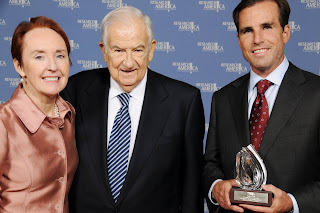As anyone who was ever gone on a diet or attempted to begin a program of regular exercise knows, changing established behavior patterns is difficult even when you know it’s good for you (and sometimes because you know it’s good for you). So the appeal of the soda tax is two fold:
- It has the potential to provide significant revenue streams to help defray the cost of health care
- It will discourage people from drinking soda which will have a positive impact on health.
It’s helpful to compare soda with other items subject to a sin tax: cigarettes and alcohol.
Cigarettes recently underwent a 150% tax increase from $0.40 to $1.01 per pack, but even at the previous tax rate, federal revenues on cigarettes came to approx $15B in 2007. That’s both a lot of money and absolutely shocking number of cigarettes (assuming 20 cigarettes a pack, that’s 750 trillion and an entirely separate health problem).
Alcohol gets a tax rate that differs between beer, wine and spirits, but combined the sin tax brings in around $5B. If we use the beer tax of $0.05 as a guideline for a potential soda tax, we get some large numbers.
Last year Americans consumed 10.2B cases of soda (at 24 cans in a case thats 244,800,000,000 cans). Not diet soda mind you, the incredibly sugary (and better tasting if we’re honest) soda. If we apply the beer tax of $0.05 to this, we get $12.4B in revenue or 19% of President Obama’s proposed health care initiative. This doesn’t affect diet sodas, juices or iced tea. That’s 19% of the massive health care reform taken care of being charging you an extra nickel for your coke.
That's a ten percent increase on a can of soda bought in a 12-pack. In the past a 10% increase in the price of soda saw a decrease in consumption of as much as 8%. Now correlation is not causation, but it’s impossible to look at those numbers and not see that they’re linked.
The economically disadvantaged are most at risk for obesity and part of that is they are the leading consumers of soda. Soda is often the cheapest item in the store.
So, to some degree, the tax targets the economically disadvantaged. But, they stand to benefit the most from the proposed health care reform this kind of economic behavioral incentive is designed to support.
As for those who think this kind of economic incentive doesn’t work, try to remember that 42% of Americans smoked in 1965. 42%. While health awareness campaigns have certainly played a role in the decline, the rising cost of cigarettes (primarily due to taxation) has significantly contributed to the decline of American smokers.
 We can’t begin to confront the obesity problem until we begin to confront the sources of that problem. It’s nice to encourage exercise and diet as a means of losing the weight, but the best medicine is the preventive kind. I think if we can cut soda consumption and pay for 19% of a reformed health care system, I say bring it on.
We can’t begin to confront the obesity problem until we begin to confront the sources of that problem. It’s nice to encourage exercise and diet as a means of losing the weight, but the best medicine is the preventive kind. I think if we can cut soda consumption and pay for 19% of a reformed health care system, I say bring it on.Besides, I’m a juice drinker anyways.
Sources:
All tax data taken from www.taxpolicycenter.org
Price data taken from www.peapod.com




















